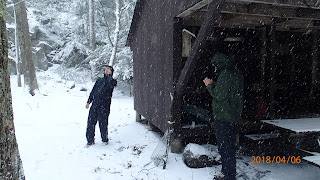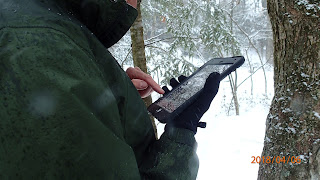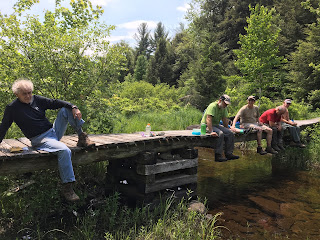April 2018
Why are these men standing around in the woods on a snowy afternoon?
 |
Adam Brown (right) enters data
on a tree at Tom Leonard shelter |
We'll need to go back to March 2015, when in Maryland, an AT hiker was
tragically killed by a falling tree at an AT overnight site. That you may not have ever heard of this event is an indication of how rare this sort of thing is. However, our forests are changing; climate and invasive species are putting new stresses on trees. Increased numbers of Trail visitors are putting more people in the woods. ATC, local AT Clubs, and land managers (such as Mass DCR and the NPS) need to know both the overall magnitude of the issue, and develop ways to address areas where visitors may be at unusual risk.
We recreate (and work) in the woods without much undue thought about the potential risks present in that environment. I think we are all aware of things like slippery rocks and roots, steep slopes and the heat and cold of our Berkshire climate. We are also aware of risks from living organisms (plants, insects, and the occasional mammal)--now we have to worry about trees falling on us? Don't we go to the woods to get away from the worries and concerns of so-called "normal" life?
As you probably surmise, these risks, while not zero, are relatively minor, as most people who venture onto the Trail do return in good health, 'tho there are a small percentage of strains, sprains and bites, and very occasionally a more serious injury that requires medical attention.
So what's with the trees?
Trees are living things, and are not a uniform crop. They are young, old, healthy, ill and even dead and still standing. Their lifespan and health varies, and is affected by climate, weather, location and attacks from natural (fungus, insects, animals) and human (careless or clueless) activity. If you want to think long term (and indulge in a little paranoia), every tree near you in the forest is a hazard tree--eventually.
Fortunately, tree time is very slow, and barring an extreme event such as intense storms, or prolonged drought or fire, nearly all trees will continue to stand for decades or centuries. But in a large population, there are always trees that are reaching the end of their lifespan or have suffered some localized damage that is causing an early demise (especially if presented with new stressors like an invasive insect or fungus for which they have no natural defenses). One of our jobs as Trail stewards is to attempt to anticipate which trees are likely to present an unusual risk to Trail visitors.
Where is it dangerous?
When you are hiking, you are a moving target, the odds of being exactly where a tree (or large piece of a tree) is going to hit the ground at a particular instant are astronomically small. However, when you aren't hiking (eating lunch, admiring a view or sleeping) your chances do increase. So our main concerns are at places of congregation, that is to say, parking areas/trail heads, viewpoints, and overnight sites. At these sites, we look at likely "targets" where hikers are stationary for a period of time or some property is at risk: shelters, privys, established tent sites and tent platforms. Your car.
There will always be the chance that we missed a tree during a survey, or a tree that appears perfectly healthy will fall due to factors that can't be identified from an external examination from the ground or will fail in extreme weather events.
Looking for hazards
 |
| Jim Pelletier (left), checks a tree for overhead problems |
At each of these locations, trees are examined for "defects". These can range from dead or broken branches, weird growth patterns that cause weak internal structures, rot, holes, fungus, (and yes, people being stupid with axes, hatchets and knives carving, or cutting tree trunks). These defects are given specific values and the total score determines whether a tree is "monitored" or "removed". When there are overhanging dead or damaged branches on an otherwise healthy tree, we will seek to prune those off.
 |
A tablet is used to record GPS data and observed
defects in each tree. |
On the AT in Mass, there are 14 overnight sites and nearly as many parking areas as well a several viewpoints. While volunteers informally check for potentially hazardous trees while at these locations on other tasks, the formal inventory process is extensive and detailed.
 |
Clearing a hazard tree at
Race Brook Falls campsite |
 |
Professional arborist climbs
to clear weak branches |
Once a site is inventoried, the next step is to remove (or prune) the trees that present the highest risk and annually monitor the trees that are of concern, but don't seem to be eminently dangerous. We can't simply cut down all the trees at a site as a proactive measure, that would fundamentally change the experience we are trying to preserve.
Very occasionally, a tree may be so obviously
 |
| Glen Brook shelter. |
 |
| Glen Brook campsite. |
ready to fall, or shed major pieces, that the site is closed until it can be addressed. When this is the case, signage will be prominently posted and the area may be physically closed with hazard tape or brush. This is extremely rare, but there are always delays in addressing trees identified as hazards. Resources are not infinite, and some trees require specialized knowledge and skills to prune or fell. It's not like the street outside your house where a bucket truck can drive up and take the tree down from the top in a few hours.
Risk is Everywhere, but it's not Everything.
Trail visitors are always responsible for their own safety. The AT is inherently a natural environment with limited human intervention. Even at congregation areas, the effort is to provide as natural an environment as possible. What can you do to mitigate your own risk?
- Look up. Are there any branches that are broken or dead (no leaves or the bark is falling off)? Hanging at an unnatural angle?
- Look down. Do adjacent trees have large holes in the trunk or large areas of damaged bark? Are there large splits or cracks in the trunk. Is the trunk covered with fungus (moss and lichens are usually not a problem, they live on the surface of the tree). Are the roots loose or pulling out of the ground?
- Look around. Are there trees that are leaning at a significant angle? Are they angled over the spot you've chosen to set up your tent or have some lunch?
If you see these indicators, you may want to consider a different location--especially in windy or wet weather (water adds to the weight of leaves and branches).
Finally, if you see anything that concerns you, report it to us
at@amcberkshire.org and we'll get out to take a look.
Please do enjoy your visit to the AT. Overall, significant injuries are rare, and fatalities are even more so. That doesn't mean you should not seek to be wise to the ways of the woods and be aware of your physical surroundings. As always if you want to join us in our efforts, you can see what we're up to at
amcberkshire.org/at








 Soon, the main part of the dock was in place, now time for the platform at the end. Same procedure, but the water was a bit deeper. At one point, we sent a "diver" down to move some rocks out of the way.
Soon, the main part of the dock was in place, now time for the platform at the end. Same procedure, but the water was a bit deeper. At one point, we sent a "diver" down to move some rocks out of the way.












